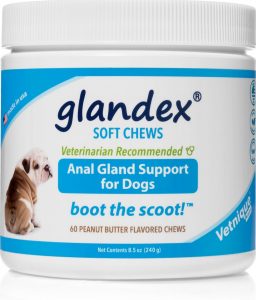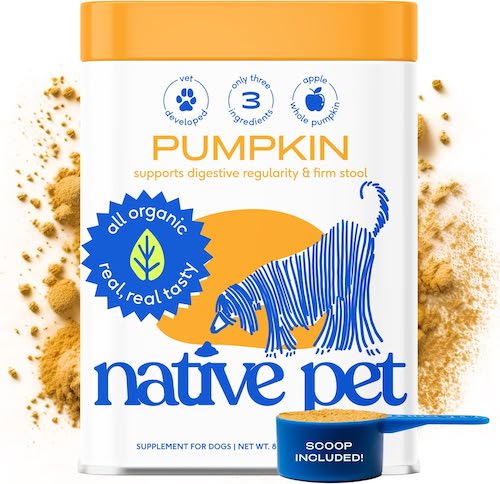- This post contains affiliate links. Read more here.
- This article has been reviewed by a pet health professional. It is not a substitute for professional veterinary advice.
Fiber plays a crucial role in your dog’s health. It aids digestion, supports gut health, and helps maintain a healthy weight. But how much fiber do dogs really need?
Most healthy dogs do well with the 2-5% fiber found in commercial dog foods. However, dogs with specific health concerns may benefit from a higher fiber intake, sometimes up to 10%. This includes dogs with chronic digestive problems, weight challenges, or diabetes.
Understanding canine nutrition can be tricky, so we consulted an experienced pet nutritionist and a veterinarian for guidance. They’ll weigh in on the benefits of fiber for dogs, tips on how to add it to their diet, and the potential risks of overdoing it.
Benefits of Fiber for Your Dog
Just as fiber benefits humans, it offers several health advantages for dogs.
Digestion
“The most common benefit we think about with fiber and dogs is bowel movements,” says Trevor White, a Certified Canine Nutritionist and the founder of dogged. Fiber helps regulate stool consistency by adding bulk, softening it, and stimulating the movement of waste through the GI tract. This creates healthy poops that aren’t too hard or too loose and can help prevent issues like constipation and diarrhea.
Weight management
Fiber also helps dogs maintain a healthy weight by promoting a feeling of fullness. It can help your pup feel satisfied with fewer calories, which may reduce overeating and begging behavior. This is especially important for dogs prone to obesity.
Healthy gut environment
Certain types of fiber act as prebiotics, feeding the good bacteria in your dog’s GI tract. A healthy gut microbiome enhances nutrient absorption and metabolism. It may also give your dog’s immune system a boost and help them fend off illness.
Diabetes management
Fiber can also help stabilize blood sugar levels, says Dani Dominguez, certified Pet Nutrition Coach and founder of SunBright Wellness. This makes it a valuable addition for dogs with diabetes. By minimizing spikes in blood sugar after meals, fiber helps keep your dog’s energy levels steady and promotes better overall health.
Anal gland health
By adding bulk to stool, fiber aids in the proper emptying of anal glands and prevents inflammation.
Safe Sources of Fiber for Dogs
According to White, it’s generally safe to offer dog-safe fiber-rich fresh food toppers without a vet’s approval, as long as they make up 10% or less of your dog’s daily caloric intake. However, if you’re considering switching to a high fiber diet or supplements, it’s wise to consult your veterinarian. They can recommend the optimal amount of fiber to offer based on your dog’s unique needs.
There are three main ways to introduce fiber into your dog’s diet: natural foods, supplements, and specially formulated high-fiber dog foods. Here’s a closer look at each option.
Natural foods
Adding fiber through natural foods is often the best approach, says White—as long as your dog will eat them. Some pups won’t love the texture or taste of fresh fruits or veggies.
Natural foods are convenient, usually more budget-friendly than switching to a high-fiber kibble, and easy to add as a topper to meals. This method is great for general health but is not as effective for managing chronic conditions, since regulating fiber amounts can be trickier.
Our experts recommend these fiber-rich options:
- Canned pumpkin (plain, not pumpkin pie filling)
- Apples
- Blueberries
- Sweet potatoes
- Green beans
- Leafy greens, like kale
- Grains, like oats and barley
- Legumes, like lentils
Supplements
If natural foods aren’t helping, White suggests moving on to supplements like pumpkin powder or psyllium husk. These can be effective for temporary issues like constipation and are readily available over the counter.
Fiber supplements come in chewable tablets and powders. You can simply mix the powder with your dog’s regular meal.
When introducing a supplement, Dominguez advises starting slowly to avoid upsetting your dog’s stomach.
High-fiber kibble
Switching to a high-fiber dog food is recommended for managing chronic conditions such as diabetes or persistent diarrhea. Studies have shown that high-fiber dog food can improve stool consistency and defecation, often within a day of starting this diet. These foods source fiber from whole grains (brown rice, oatmeal), pea fiber, and fiber-rich fruit and vegetables.
You can find high-fiber dog foods at your local pet store, though many require a veterinarian’s prescription. For instance, some pet parents have had success with Royal Canin’s Gastrointestinal Veterinary Diet. Another good option is Hill’s Prescription Diet Gastrointestinal Biome Food.
While these diets can be pricier, they offer a reliable way to ensure your dog receives the right amount of fiber, as well as a complete and balanced nutrition profile.
-
Viktoriya Telminova via iStock
When To Use Supplement Fiber in Your Dog’s Diet
While most healthy dogs will get enough fiber from their regular pet food, some may benefit from additional fiber in their diet. Whether your dog is facing a temporary issue or a long-term health challenge, it’s always best to discuss fiber options and amounts with your veterinarian.
Which health conditions benefit?
- Irregular bowel movements. If your dog frequently experiences constipation or diarrhea, their diet may need more fiber. A 2021 study revealed that psyllium improved stool consistency and reduced defecation frequency in dogs with chronic diarrhea. Remarkably, improvements were noted even after the supplementation period ended.
- Anal gland issues. Dogs with recurrent anal gland problems may find relief by increasing their fiber intake. “Firm stools naturally help express the anal glands, reducing the risk of impaction,” notes Dr. Marc Smith, veterinarian at Natchez Trace Veterinary Services.
- Inflammatory Bowel Disease (IBD). Research indicates that fiber can effectively treat IBD in dogs.
- Diabetes. A high-fiber, low-fat diet is often recommended for diabetic dogs. Dr. Smith explains that fiber helps stabilize blood glucose levels by slowing the absorption of sugar in the digestive tract.
- Hairballs. Although they’re usually associated with cats, some dogs are prone to hairballs. Increasing fiber intake can help move hair through the digestive system, minimizing the chance of hairball formation.
Which types of dogs benefit?
- Senior dogs. Older dogs may struggle to digest and absorb nutrients as efficiently as their younger selves. A fiber-rich diet helps counter some of the changes that come with age, improving your senior dog’s comfort and overall quality of life.
- Overweight dogs. If your dog struggles with weight, adding fiber to their diet can help them feel full longer and reduce overeating.
- Dogs with chronic health conditions. Dogs dealing with ongoing health issues, such as diabetes, often require specialized high-fiber diets.
Product Recommendations
These over-the-counter supplements contain fiber-rich ingredients, which may help keep your dog regular.
Glandex Anal Gland Support Soft Chews
Healthy poops equal healthy anal glands! Anal glands are not the prettiest of topics, but the butt scooting is real. These peanut butter flavored chews are corn-, wheat-, and soy-free, and blend together fiber, digestive enzymes, and probiotics to create more substantial, firm stools that help empty glands come potty time.
Shop on ChewyNative Pet Organic Pumpkin Fiber Powder
This versatile powder can be sprinkled on kibble, mixed with water to create a delicious purée, or even frozen for a refreshing treat. Whichever way you choose, it’s a simple way to support your pup’s digestive health.
Shop on ChewyPet Honesty Fiber Powder
This powder supports your dog’s digestion with a blend of pumpkin, psyllium husk, and apple pectin. You’ll also find gut-boosting probiotics and prebiotics.
Shop on ChewyIs Too Much Fiber a Thing?
Yes, too much fiber can be a concern for dogs. While fiber is important for digestion, excessive amounts can lead to abdominal discomfort and unhealthy changes in eating habits. Dr. Smith also warns that excess fiber can hinder the body’s absorption of essential nutrients like calcium and zinc. Over time, this could potentially lead to malnutrition.
Dominguez and Dr. Smith identify the following signs you’re offering too much fiber:
- Gas
- Bloating
- Diarrhea
- Constipation
- Straining (despite soft stools)
- Decreased appetite
- Weight loss
If you notice these signs after adding fiber to your dog’s diet, Dominguez recommends cutting back and talking to your vet.







